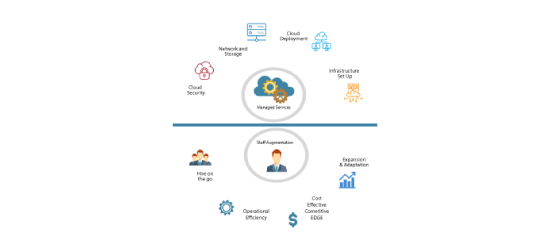
| Author: Ashish Kumar | Published: 19-Mar-2021 |
Staff Augmentation Vs Managed Services: A Closer Look.
One of the first—and biggest decisions—facing CTOs considering migration to the cloud is whether to beef up human resources or engage a cloud managed services provider. Both have their pros and cons and the right answer as usual is depends!
No two companies are the same, nor are their objectives and situations; thus the first step logically would be to look at your current model through the prism of new technologies. This way you will be able to see the gaps that exist—and will be manifest in the future. And be better positioned to decide.
This article sets out the pros and cons of both.
Staff Augmentation
At its most basic, staff augmentation is simply a flexi-BPO model that supplements your internal IT team with IT resources that have the skill-sets you need at a particular point in time. This is a good short- to medium-term strategy as it allows a business to satisfy its needs using a pool of IT resources as per their short or longer term needs.
Staff Augmentation Benefits
This biggest benefit is the cost savings involved in hiring new resources—as long as the requirement is not permanent.
Since you can engage staff with specific skill sets—which may change as per your needs—it allows businesses to meet business-critical needs without the hassles that go with long term recruitment. It also does away with the need to retain staff whose skills may have become redundant or unnecessary as business needs and technologies evolve.
Limitations
Although you save on costs incurred with permanent recruitment, there are still costs involved in managing augmented staff and these add up, making it unfeasible for longer running projects.
You are also partly-dependent on external parties for managing the project; if this is not efficient, it can slow down the process and render the engagement unviable.
Managed Services
When you engage a managed services provider (MSP) you’re outsourcing your IT—entirely or some aspects—with the objective of improving your operations. The MSP’s team functions as an extension of your own team. Thus you get the support and services as if your own internal team were providing it. Like staff augmentation, MSP models too allow you to meet specific needs without hiring an in-house resource.
Cloud Managed Services Benefits
Since MSP pricing is dependent on the outcome demanded by the engaging business, it is a scalable cost model.
MSPs maintain a large and relevant pool of resources—much bigger than staff augmentation providers—making it easier for you to meet shifting requirements.
MSP engagements spell out terms like scope of work, and timelines. The MSP is also committed to meeting specified service level agreement. This in turn assures completion of a project as per the commitment, improving your own brand value.
Limitations
The entire concept of MSP hinges on their ability to provide the talent and capabilities you need; in reality, however, finding the MSP with resources that align with your own objectives can be a challenge.
MSP pricing is often complex, and since charges are usually by-the-hour, it can be difficult to budget pricing to project needs.
What’s the best fit for you?
Finding the best solution for your business comes down to your business objectives and needs. Short term projects usually do better with staff augmentation, while long term engagements are generally better off using a MSP, as it frees the business from the hassle of routine IT management so they can focus on core business needs.
Still unsure which model to choose? Talk to us. Our experts will be happy to answer your queries and help you choose the best-fit model for your needs.
 close
close

Hi there! At TeleGlobal, we turn your cloud vision into AI-accelerated reality. What challenge can we help you solve?
Powered by ![]() teleBot
teleBot